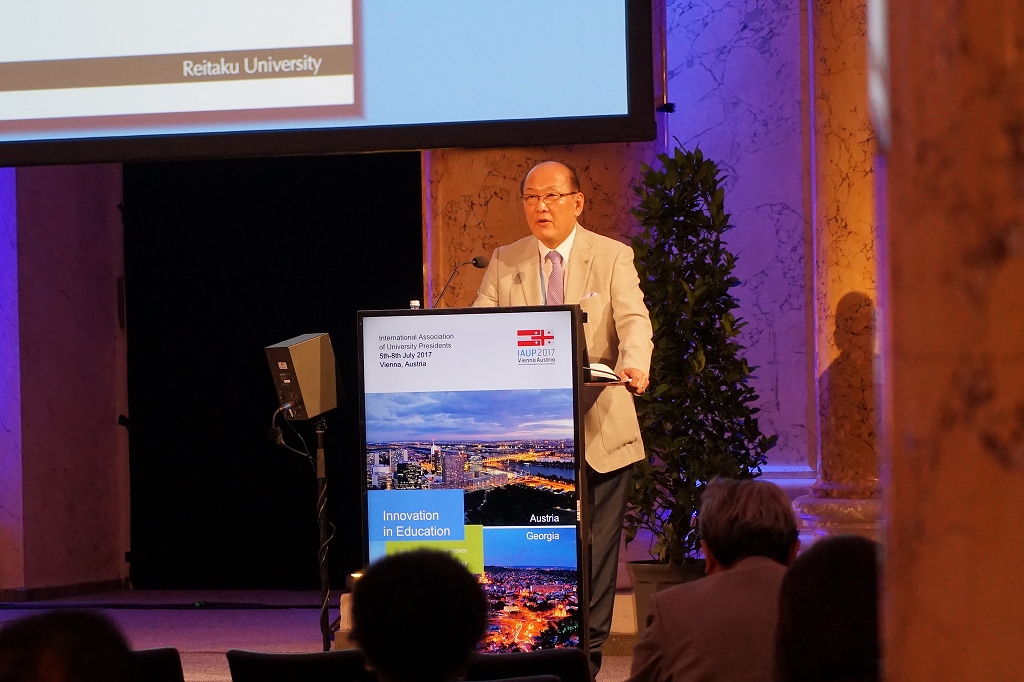IAUP Triennial Conference 2017, 5-8 July 2017, Vienna (Austria)
 Every three years, the International Association of University Presidents (IAUP) convenes its general assembly in a different part of the world. Each triennial meeting focuses on a specific theme designed to stimulate discussion of the changes and challenges facing higher education worldwide. Between July 5th and 8th, 2017, the IAUP held its XVIII Triennial Conference in Vienna, with the main theme being Innovation in Education. President Nakayama participated in a session on Thursday the 6th and gave a lecture entitled, “New Trends in Education: How Can Japanese Universities Contribute to the New System of Moral Education?” This is the second time he has offered a lecture at an IAUP triennial; the first was at the IAUP XVll Triennial Conference 2014 in Yokohama. An abstract of his 2017 paper appears below:
Every three years, the International Association of University Presidents (IAUP) convenes its general assembly in a different part of the world. Each triennial meeting focuses on a specific theme designed to stimulate discussion of the changes and challenges facing higher education worldwide. Between July 5th and 8th, 2017, the IAUP held its XVIII Triennial Conference in Vienna, with the main theme being Innovation in Education. President Nakayama participated in a session on Thursday the 6th and gave a lecture entitled, “New Trends in Education: How Can Japanese Universities Contribute to the New System of Moral Education?” This is the second time he has offered a lecture at an IAUP triennial; the first was at the IAUP XVll Triennial Conference 2014 in Yokohama. An abstract of his 2017 paper appears below:
///
When we consider moral education in the Japanese tertiary sector today, we cannot ignore the fact that large numbers of university professors are in accord with the tenor of the remarks about the place of morality and ethics in higher education made by the political scientist, John Mearsheimer. In Debating Moral Education (Duke University Press, 2010) Elizabeth Kiss and J. Peter Euben drew attention to Mearsheimer’s controversial 1997 address to the University of Chicago freshman class on the “Aims of Education”, in which he argued that the chief purpose of a university education was “to help students think critically, to broaden their intellectual horizons, and to promote greater awareness.” From this premise, Mearsheimer deduced that a university had to be “a remarkably amoral institution”, one that did not, and should not, provide its students with “moral guidance”, nor offer courses in which they could “discuss ethics or morality”.
The situation in Japanese tertiary education at the time of his speech would probably have pleased Mearsheimer, since in 1997 moral education was provided solely in the country’s elementary and junior high schools. Instruction ended abruptly at age fifteen, and things have only just begun to change. Not until the start of the 2014 academic year was moral education extended to some, but by no means all, high schools, and that remains the high water mark. Sadly, the idea that universities have a civic responsibility to teach their students morality and ethics still encounters scepticism, suspicion and, on occasion, outright rejection. So it is no surprise that moral and ethical education is not especially common at university level in our country today. This is consonant with a widespread belief in Japan that such concerns are the province of the home, and of instruction in elementary and junior high schools where moral education is a requirement under the Ministry’s official guidelines for teaching. The fact of the matter is, though, that even elementary and junior high schools do not always seem to achieve satisfactory results in moral education when tackling a variety of problems.
We are at last, though, on the threshold of significant changes in the matter of moral education. In 2016 the Ministry of Education, Culture, Sports, Science and Technology decided that moral education will become a “special subject” in the next national curriculum, and so a new moral education system will start in elementary schools in the 2018-2019 school year, and in junior high schools in the 2019-2020 school year.
Despite strong official backing, though, the new system has not gone unchallenged by those responsible for teaching the subject. This is partly because moral education has not been a school subject since World War II, so Japanese universities have neither academic departments nor faculty solely devoted to scholarship or instruction in the area of moral studies. As a result, they have not to date produced researchers and educators specializing in the subject in sufficient numbers; courses on the “methods of teaching morals”, a required subject in teacher-training programs, are therefore sometimes offered by faculty who are not specialists in moral education. Such courses, which are supposed to provide students with a comprehensive grasp of the objects, content and methods of moral education, attract just two credits for one 90 minute class per week for fifteen weeks. This paucity of provision for moral education in teacher training programs in Japanese universities has inevitably done considerable harm to the prospects of advancing the cause of moral education in elementary and junior high schools.
This narrow, if important, problem of teacher training should stimulate us to rethink the place of moral education in Japan’s entire tertiary sector. In the U.S., for example, a new trend, completely at odds with Mearsheimer’s ideas, has already emerged. After being marginalized for decades in the secularized 20th century academy, more than 100 ethics centres and programmes are now flourishing on campuses across the country, evidence of a renaissance in moral education in the American tertiary sector. In this globalized age, moral education in Japan can no longer be allowed to lag behind, but must seize the future by participating in collaborative academic and educational initiatives worldwide.



